Originally, San Francesco was outside the walls of the city, and the arch at the bottom of via dei Rossi into the Piazza San Francesco, called Arco dei Frati Minori or Arch of the Minor Friars, was the gateway through the city walls. However, the 15th century Sienese Pope Pius II, whose parents were buried in San Francesco, was keen that the church should be brought within the city, and a new set of walls were built behind San Francesco.
Just before the arch into the Piazza San Francesco (one of Siena’s most attractive open spaces), it is worth glancing at the modern trompe-l’oeil marble statue of a topless woman at a window, on the left. Just below her, on the opposite side of the street and more or less under the via dei Rossi, lies the ancient Fonte di San Francesco, one of the old fountains that supplied Siena with water in the Middle Ages. It is now the contrada fountain of the Contrada of the Caterpillar (Bruco).
The Franciscans, who had a healthy rivalry with the Dominicans, usually built their churches bigger than anybody else’s, and San Francesco in Siena is no exception. It is a vast Gothic redbrick building, built in the 1200s and enlarged some hundred years later. It is largely unadorned on the outside, apart from the Gothic main door with rose window above. These are in fact 20th century pastiches; the façade was pulled down between the two world wars as it was thought to be dangerous and rebuilt. Originally, there were tiger stripes on the lower part of the façade and a quite different doorway, now to be seen inside the church.
The interior has been painted to resemble black and white marble as in the Duomo. The church was once far more garishly coloured inside, however, as can be seen from the traces of the original decoration in the chapels of the transept.There is not much to see in the huge bare nave, apart from some fragments of fresco and, on the left of the entrance, the magnificent renaissance main doorway by Francesco di Giorgio Martini (1439-1502) which adorned the façade before its rebuilding. Rather incongruously, it now frames what is almost a trompe l’oeil modern painting of the modern holy man Padre Pio. A number of large and not particularly distinguished oil paintings have been mounted on ugly iron frames in front of the side chapels instead of being hung in the alcoves of the chapels as was surely meant.
The works of real interest are the frescoes by the Lorenzetti brothers in the chapels to the left of the high altar, all that survives of what must have been an extraordinary array of wall decoration. The chapel immediately on the left of the high alter (light switch just inside the chapel, on the right) contains an intensely tragic crucifixion by Pietro Lorenzetti; even the angels in the sky have tortured faces and attitudes and it is one of the most moving paintings in Siena.
..... 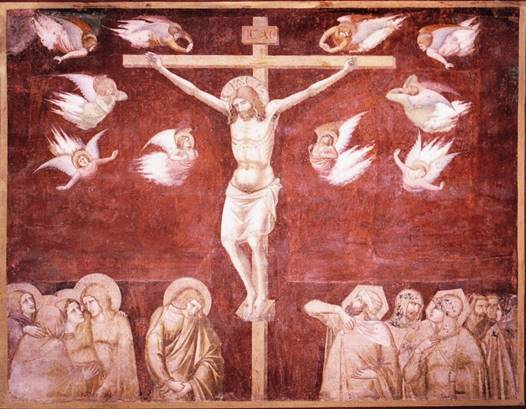
In the third chapel to the left there are two frescoes by Pietro’s brother Ambrogio, unfortunately less well preserved (light switch again just inside the chapel on the right). That on the right shows St Louis of Toulouse taking leave of Pope Boniface VIII, after he had renounced the throne of Sicily in favour of his brother Robert d’Anjou, seen here wearing his new crown and seeming far from pleased with it.
That on the left shows Franciscan friars being martyred in Morocco in 1227 while on an ill-fated mission to convert infidels. Note the oriental dress and features of some of those doing the martyring, more suitable to somewhere much further east, but no doubt Lorenzetti had never seen a Moroccan. All three frescoes were painted in the first half of the fourteenth century, and introduce a depiction of character that was then new to Sienese painting.
In the end chapel on the far left of the high altar there is a pleasant 14th century fresco on the side wall of the Virgin and Child by Jacopo di Mino, dating from 1400. But all except one of the paintings over the altars in the chapels are 19th century works in 14th century style. The exception is in the first chapel to the right of the altar, where there is a genuine 14th century Madonna and Child, unfortunately badly burnt in a fire in 1655. There is also some carving worth a look. On the steps to the chapel to the far right of the high altar there are two attractive 15th and 16th century tombstones, and two chapels further on, a fine 15th century sarcophagus of Cristoforo Felici, sculpted by Urbana da Cortona, is set high in the left hand wall .
On the opposite side of the right transept, a door leads into another chapel containing a frescoed Virgin and Child with Saints by the 14th century Lippo Vanni, painted to look like a polyptich in an ornate Gothic frame (unfortunately difficult to see because of the poor lighting). Off the left transept, opposite the chapels with the Lorenzettis, there is a large chapel with good pavement decoration, but frustratingly unlit and barred to visitors.
There are no fewer than three cloisters belonging to the monastery that used to be attached to the church. The first “Piccolomini Cloister” is accessible through a door next to the main entrance to the church. It is now occupied by the Law and Economics faculies of Siena University and is open during normal working hours. It was originally Gothic in style (two of the Gothic arches can be seen in the wall in the far corner), but was redone in elegant renaissance style in 1517 by a Piccolomini bishop – the Piccolomini crescent moon appears at the top of each arch. On the left side of the cloister there are steps up to the church with 18 identical crests (rather damaged) of the Tolomei family, another major Sienese family, commemorating 18 Tolomei men who were according to legend treacherously murdered by the rival Salimbeni family and are now buried underneath.
The second cloister, known as the Sansoni cloister, is reached through a door to the right of that leading to the Piccolomini cloister. It dates from the 15th century but has been knocked about quite a lot. Until recently, it was part of a barracks, but the soldiers have now moved elsewhere and it has also been taken over by the University. The third cloister is closed to the public. What remains of it can be glimpsed through a door on the left side of the nave of the church.
In 1730, a thief stole a precious receptacle containing some 350 consecrated hosts or communion wafers (particole), to the consternation of the population. The thief appears to have been interested only in the receptacle, as the hosts were found a month later stuffed in the offertory box of the neighbouring church of Santa Maria in Provenzano in a somewhat cobwebby state. A huge procession of clerics and townsfolk returned them to San Francesco, where they appear to have been put away (curiously, as consecrated hosts are seen as the body of Christ and are not normally kept for any time before being given in communion). Some 50 years later, somebody remembered them and examined them, to find that they were in a pristine state. This was seen as a miracle, and they were put safely away again. Since then, they have been examined at intervals, with some each time being tested for taste and consistency, and found still to be uncorrupted. What remains of the hosts after the testing etc. is still kept locked away in a chapel in San Francesco, being brought out for special occasions.
Revised 2003, 2012 and 2015.
******************************************************************************************************
SANTA MARIA DELLE NEVI (Saint Mary of the Snows)
This tiny church at No.1 via dei Montanini at the top end of the Banchi di Sopra, on the ancient pilgrim route of the via Francigena, is hardly ever open. But on one of its rare opening days during the summer months it is well worth popping in to see one of the greatest works of the 15th century Sienese master Matteo di Giovanni.
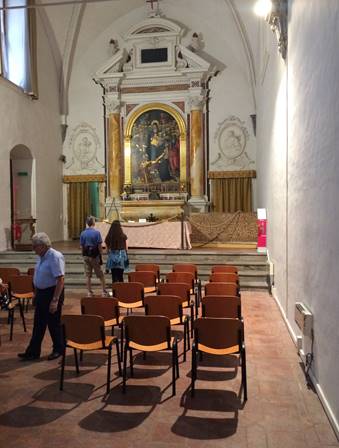
Interior of Santa Maria delle Nevi
The church was built in the 1470s. It was commissioned by Giovanni Cinughi, Bishop of Pienza, whose family palace was nearby and who intended it for use by his family. He dedicated it to Our Lady of the Snows, an allusion to the legend of a miraculous snowfall in Rome on 5 August 352 AD which was predicted by the Virgin Mary to the then Pope in a vision. She told him to build a church to her on the ground covered by the snow, which he duly did – subsequently replaced by the present church of Santa Maria Maggiore – with the financial help of a rich Roman nobleman to whom the Virgin had also appeared.
Santa Maria delle Nevi has an agreeable Renaissance travertine façade and a bright interior not predictable from the outside. The wonderful painting by Matteo di Giovanni over the altar is dated 1477 and was specially commissioned for the church. The main panel shows the Madonna and Child surrounded by saints and angels, the latter holding both individual snowballs and whole dishes of snowballs. St Peter with his key stands to the right of the Virgin and St John the Evangelist is on the left, clutching as usual a book with his Gospel. Kneeling at the Virgin’s feet are St Lawrence holding the gridiron on which he was said to have been martyred by the Romans; and St Catherine of Siena in her black and white Dominican robes. The predella below the painting has scenes showing the miracle of the August snow, which has fallen in a way that indicates exactly the ground-plan of the new church to be built.
Sienese painters were very conservative and slow to adopt Renaissance innovations, but this painting does have some Renaissance touches with e.g. the perspective of the throne.
On either side of the altar are stuccoes of St Joseph (unusually in hands-on father mode holding the infant Christ) and of Santa Maria Maddalena de’ Pazzi (a Florentine nun and mystic) attributed to the 18th century sculptor Giuseppe Maria Mazzuoli (1727-1781).
2019
************************************************************************************************
SANTA MARIA IN PROVENZANO
... ... 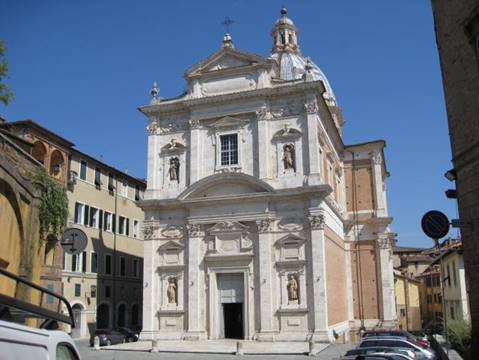
This church near San Francesco has one of the most attractive façades in Siena, built of clotted cream-coloured travertine in a baroque or mannerist style. It is set in quite a large piazza, enabling one to admire it with a fair degree of distance.
The church was consecrated in 1611 and contains a 14th century terracotta statue of the Virgin Mary (high above the alter in a glass case) which became associated with a number of miracles. It was in honour of this statue that the first July Palio in the Piazza del Campo was run in 1656, originating a tradition that continues to this day. At the time of the July Palio, the church is filled with the swirling flags of the contrade, and echoes to their drum rolls. On the evening before the Palio, the silk banner of the Palio is brought here and blessed. The next morning a solemn mass is said for all the contrade, and after the Palio members of the victorious contrada process to Santa Maria in Provenzano and sing a Te Deum of thanksgiving (for the August Palio, the Duomo is the church where all the ceremonies take place).
2012.
*********************************************************************************************************
SAN PIETRO ALLA MAGIONE; SANTA MARIA IN PORTICO; and PORTA CAMOLLIA
Two moderately interesting small churches near the Porta Camollia, Siena's main northern gate.
San Pietro alla Magione
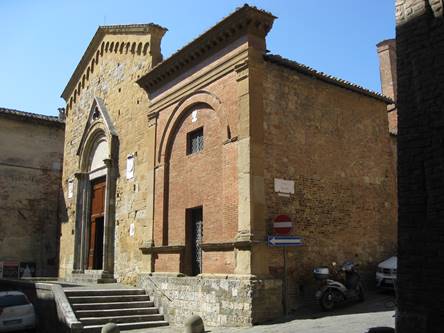
San Pietro alla Magione with its later brickbuilt extension on the right
This little Romanesque church, on the right about a hundred metres down the via Camollia, would have been the first church that pilgrims entering Siena encountered. In the 12th century, the Kinghts Templar, a Christian military order founded during the Crusades to defend and give succour to pilgrims travelling to Jerusalem, set up a hospice (probably a cross between a hostel and a hospital) by the church, La Magione – the word comes from the French “maison” – and also took over and probably built much of the present church (although there has been a church here at least since 998).
The stone-built church is a few steps up from the street and is very plain and simple, although a triangular marble Gothic arch has been added rather incongruously to the Romanesque entrance. The inside is even simpler, a single nave and no ceiling to hide the roof. Note the marble Gothic tabernacle to the right of the apse, matching the church in its elegant simplicity. The brick-built chapel next to the church was built in the 1520s in thanks for the end of an episode of plague. There is a very simple open bell-tower, in a form typical of the Templars. An alley called via Malta runs down the side of the church, reflecting the fact that the church later passed to the Knights of Malta.
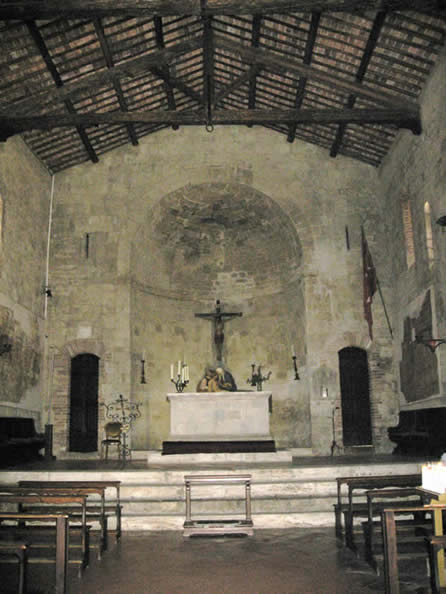
The austere interior of San Pietro alla Magione (the altar is modern).
This part of the city is in the Contrada dell’Istrice (porcupine), and the contrada fountain is behind the church, decorated with a fine porcupine. The Romans introduced porcupines from Africa to Italy and they have been in Tuscany ever since, much to the disgust of the farmers, as they eat the root crops. They come out mainly at night and their quills can quite often be found around Barontoli.
Santa Maria in Portico
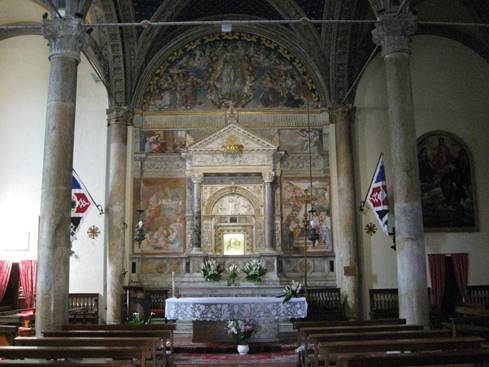
Interior of Santa Maria in Portico
A little further along on the right a small lane called vicolo di Fontegiusta leads through a portico down to the church of Santa Maria in Portico. Its front is plain brick and unadorned apart from the marble surround of the door. But inside the church is that rare thing in Siena, a Renaissance gem. It was built in the 1480s as a thanksgiving to the Virgin Mary after the Sienese victory over the Florentines at the battle of Poggio Imperiale in 1479. The church is almost square, with slender pillars and lovely renaissance arches separating the three naves. There is a glorious if arguably over-decorated marble altarpiece, surrounded by attractive frescoes of the life of the Virgin (her birth on the left; the Annunciation above; and her “Transition” – for she did not die in the normal sense – on the right by the artist Ventura Salimbeni (1568-1613) and dating from 1600.
The altarpiece or tabernacle displays a late 14th century fresco of the Virgin and Child, a much venerated and miraculous image image that was originally set in one of the old city gates as protection against enemies (the Sienese saw the Virgin as very much their personal protectress). On the right wall, there is a charming little organ-loft. The various paintings on the side walls are of limited interest – although that on the left wall near the entrance, allegedly by the painter/architect Baldassare Peruzzi, represents the somewhat unusual subject of the Sybil predicting to the Emperor Augustus the coming of Christ.
The church possesses a whalebone said to have been presented to it by Christopher Columbus, who is thought to have passed some years as a student at Siena University.
Down the hill behind the church was one of Siena’s famous fountains, the Fontegiusta, but all that there remains of it today is an archway in the city walls.,
.
Porta Camollia
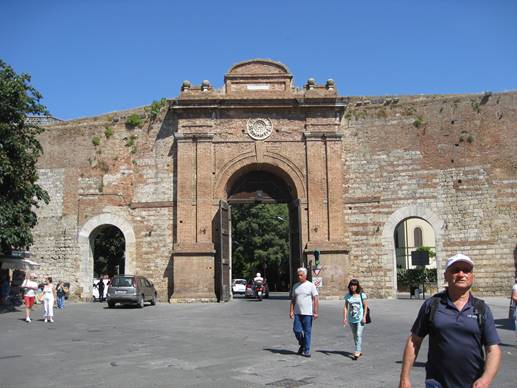
Porta Camollia, inner façade
Siena’s ancient northern gate, the Porta Camollia is at the top end of the via Camollia and was the gate used by travellers from Florence and pilgrims from northern Europe coming along the Via Francigena to Rome and Jerusalem. Because it was the gate facing Florence, Siena’s old enemy, it was one of the best defended. There is even a large secondary gate, the Antiporto di Camollia, a couple of hundred metres outside the main gate – a huge brick structure built in the 13th century and rebuilt in the 17th.
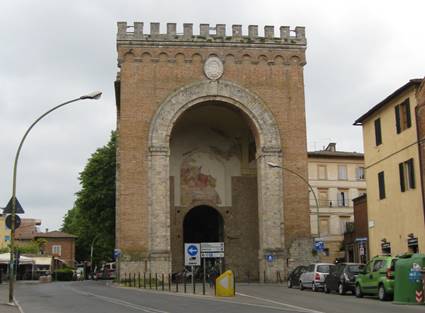
The Antiporto
The name Camollia is said to come from Camulius, a Roman who was, according to legend, asked by Romulus, the founder of Rome, to go to Tuscany to capture the the two sons of Romulus’s brother Remus, whom Romulus had murdered. The two sons, Ascius and Senus, had fled Rome and became the legendary founders of Siena. Camulius seems to have decided to throw his lot in with them, as he stayed in Tuscany, founding a settlement near where the gate now is. There is an alternative and much less romantic theory that the name Camollia comes from a nearby nuns’ convent or ca’ mulierum.
The original gate, probably dating back a thousand years, was destroyed during the 1555 siege of Siena, and the present structure was erected in 1604 when Siena was under Medici rule. The outside of the gate is decorated with the five pawnbrokers’ balls of the Medici crest, and the inscription Cor magis tibi Sena pandit (Siena opens her heart to you wider than this gate) was put there – no doubt with teeth gritted – to honour the entry into Siena of the Medici Grand Duke of Tuscany Ferdinand I.
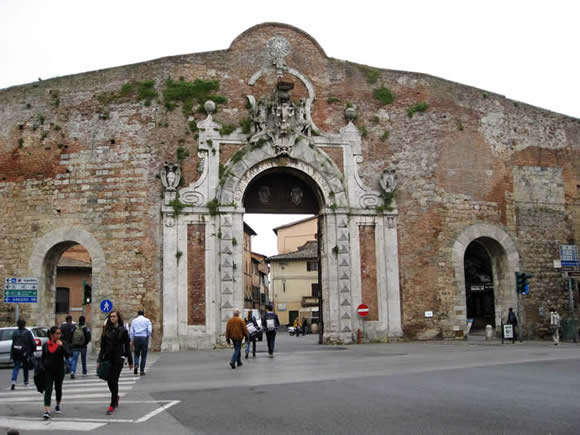
Porta Camollia, the outer façade .
The open space between the Porta Camollia and the Antiporto was used in the middle Ages for markets and fairs. On the western side stands the Colonna di Portogallo (Portugal Column), so-called as it is where Enea Silvio Piccolomini, the future Sienese Pope Pius II, presided over the meeting of the Habsburg Holy Roman Emperor Frederick III with his bride Eleanor of Portugal. Piccolomini, who was at that stage Bishop of Siena, had arranged the marriage, in a fine piece of international diplomacy. The meeting of the bridal pair, with the column behind them, is depicted in the scenes of Pius II’s life by Pinturicchio in the Piccolomini Library of the Duomo.
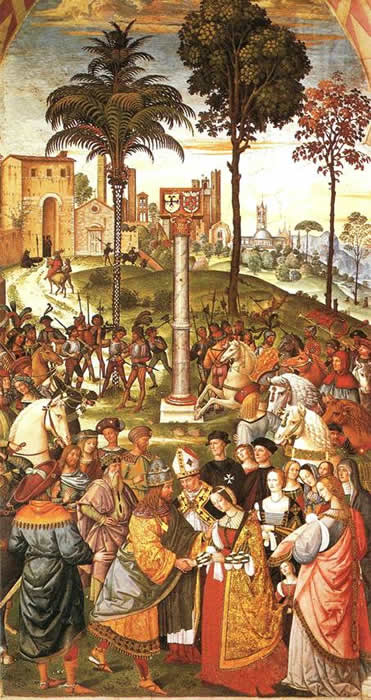
The meeting of Emperor Frederick III and Eleanor of Portugal in front
of the Colonna di Portogallo, by Pinturicchio

The column today, sadly without its gilding.
2015
-------------------------------------------------------------------------------------------------------
SANTA MARIA DEI SERVI (properly San Clemente in Santa Maria dei Servi) and the PORTA ROMANA
An impressive Gothic church with interesting paintings, near one of Siena's most imposing gates.
To get to Santa Maria dei Servi from the Campo, take the via Porrione, and go straight on for a long way, past St Martino and on until a signed road forks to the left towards the church.
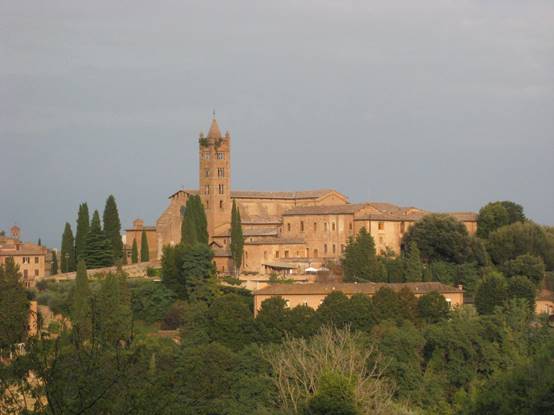
Santa Maria dei Servi, seen from the Palazzo Pubblico
The campanile is 14th century and the church was also begun in that period, so the building is mostly Gothic – although as so often with churches it took a couple of hundred years to complete, and the facade remains unfinished to this day. It is the monastery church for the Servites who live next door. Inside it is handsome and spacious and its interesting paintings make it well worth a visit. The nave and transepts are covered in painted decoration; although probably dating from the 19th century, it gives an impression of what the church was like originally. When the lights are on, the joyous gaiety is almost impious to our eyes. When the lights are off, it is unfortunately quite hard to see the paintings.
Starting on the right at the back, between the first and second chapels, there is an attractive fragment of 14th century fresco of the Madonna rescuing the souls of children from Purgatory at the time of the Last Judgement.. In the second chapel on the left is an important painting of the Madonna and Child by the Florentine artist Coppo di Marcovaldo, one of the earliest Italian painters – he probably inspired both Guido da Siena and Duccio. He was captured by the Sienese at the battle of Monteaperti in 1260, and painted this picture as the price of his freedom. It is a marvellous example of Italian Byzantine, highly stylised with great emphasis on the folds of the rich and gorgeous robes, a perfectly balanced and elegant composition.
The church has not one but two extremely gory pictures of the Massacre of the Innocents, a subject of which Sienese painters were strangely fond. The first, in the fifth chapel on the right, is by Matteo di Giovanni and has recently been restored and lovingly regilded.The second is a fresco in a chapel of the right and is thought to be partly by Pietro Lorenzetti. The agonised expressions of the mothers are powerfully rendered, and there is an interesting early example of the use of horses for crowd control. To the left is another possible Lorenzetti of St Agnes with her symbol of a lamb. Under this is the mummified body of the Blessed Francesco Patrizi, his bony hand stretched out.
In the end chapel of the right transept, there is a large and handsome 13th century crucifix of the Duccio school, as is the Madonna and Child over the door of the sacristy. Over the high altar there is a messy Coronation of the Virgin by Bernardino Fungai, and in the chapel on the far left of the altar there are yet more Lorenzetti frescoes, rather damaged, of the dance of Salome – note the head of St John the Baptist still steaming, or are they holy rays? – and of the ascension of St John the Evangelist. There is a pretty nativity above the altar of this chapel, with a hoopoe at the bottom, painted by Taddeo di Bartolo in 1404.
In the left transept, the Madonna della Misericordia is by Giovanni di Paolo, painted in 1471. The Madonna is looking rather constipated, but is elegant of shape, with curiously piercing eyes as she shelters mankind under her cloak. In the third chapel on the right, there is a Birth of the Virgin by Rutilio Manetti, with a great play of light and dark as befits a follower of Caravaggio.
Finally, before leaving, pause to admire the beautiful marble font near the door, dating from the 14th century.
Porta Romana
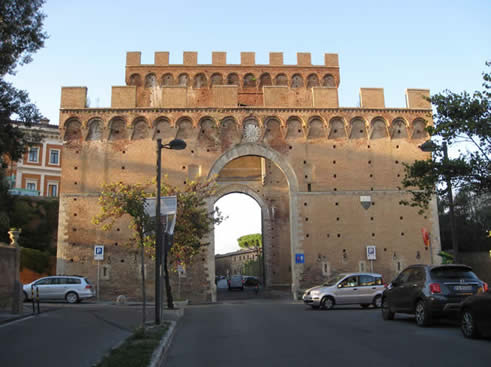
The outer gate of the Porta Romana, as seen by those approaching the city.
To the south of Santa Maria dei Servi, the road to Rome goes out of the old city through the magnificent Porta Romana (also known as the Porta Nuova), one of the largest of Siena's defensive gates. It was built in the 14th century when a new outer wall was constructed around the south of the City after it expanded beyond the previous walls. Like most of Siena's gateways, it has a double gate. The outer gate is highly crenellated, machicolated and decorative; the more sober inner gate gives more of an impression of force and power, to remind those leaving of the might and wealth of the city. In the 16th century, after Florence had finally taken over Siena, Grand Duke Cosimo I de’ Medici put the large Medici crest on the wall between the two gates. Above the inner door the space can still be seen where there was once an icon of the Madonna painted in 1417 by Taddeo di Bartolo to protect the city.
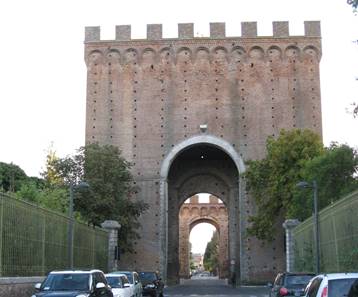
The outer gate as seen by those leaving the city down via Roma
(1980s, revised 2004)
***************************************************************************
SAN MARTINO and the LOGGE DEL PAPA
A church and an arcade near the Piazza del Campo; there is a good painting by Beccafumi inside.
They lie between the Banchi di Sotto and the Campo, about 50-100 yards down from the top of the Banchi di Sotto. The church is often closed, but worth a peek inside if the door is open.
San Martino
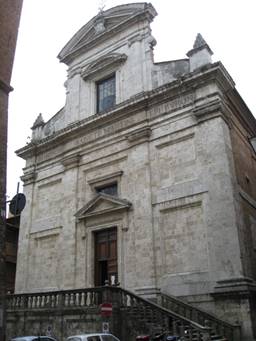
It was one of Siena's first churches, originally founded in the 8th century. The present building is much later - the sober classical facade dates from 1613, and the interior is typically over-ornamented Italian baroque, heavy and not particularly attractive. But some bits of the interior are nevertheless worth a glance. Look for instance at the handsome and beautifully carved ensemble of statuary which makes up the main altar (the sculptor is the little known 17th century Giuseppe Mazzuoli). Look also at the two statues above the two side altars on either side of the main altar. That on the left, of the Virgin and Child, is also by Giuseppe Mazzuoli, whereas that on the left (of St Thomas of Villanueva) is by another and considerably less talented member of the Mazzuoli family. The two statues are illustrative of the good and bad sides of mannerism: the Virgin is alive and full of wonderful movement, whereas St Thomas is stiff and artificial, his attitudinising merely ridiculous.
Siena's most famous mannerist painter, Beccafumi, is represented by a beautifully coloured Nativity above the third altar on the left, typical of this painter with its interesting light effects but somewhat marred by the overly sentimental circling angels in the sky. Above the second altar on the right is a stiff and rather unpleasant Circumcision of Jesus by Guido Reni. The other paintings are undistinguished - although that above the third altar on the right is said to be by Guercino, it is in such an appalling state as not to be worth looking at.
The church has a 16th century cloister, rather damaged, which can be entered through a dark passage in the Via Porrione, just beyond the church.
Logge del Papa
This pretty loggia to the left of the church is another contribution to the city by Siena’s great Renaissance patron, Pope Pius II Piccolomini (Papa is the Italian for Pope). It was built in the 1460s.
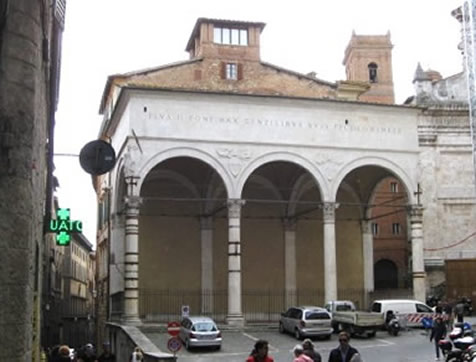
*****************************************************************************
SAN NICCOLÒ AL CARMINE, ARCO DELLE DUE PORTE and PORTA SAN MARCO
A smallish out-of-the-way Church with a magnificent Beccafumi, near two of Siena’s ancient gates.
San Niccolò al Carmine (also known as Santa Maria del Carmine) is in the Pian dei Mantellini. It is the church of Siena's Carmelite monastery. Apart from the big handsome belltower, the red-brick building itself is undistinguished, but the paintings inside are worth a look if you are nearby (Pian dei Mantellini can be reached by going up via di Citta and then on – it turns first into via Stalloregio and then Pian dei Mantellini after going through a gate in the old city wall. There are number of ancient palazzi on the way).
On the way to the church, in via Stalloreggio on the left, high on the wall of a building on the corner of via del Castelvecchio, there is a tabernacle with a painting by Domenico Beccafumi, known as the “Madonna del Corvo”, or Madonna of the Crow. Legend has it that a crow brought the 1348 plague to Siena and that it was at this spot that it fell down dead. Unfortunately, it is difficult to see the painting through the protective glass. By the gateway out into Pian dei Mantellini, there is another another 16th century tabernacle with Madonna and saints. Tabernacles of the Virgin were much favoured as the Sienese believed that she gave the city her special protection.
The Arco delle Due Porte
The gateway, known as the Arco delle Due Porte (Arch of the Two Doors) because it has double arches (one blocked for centuries), is in Siena’s oldest (11th century) wall built around the original nucleus of the City (as the ciy expanded, new outer walls had to be built). There is another tabernacle with Virgin and Child, allegedly the oldest in the city, outside the gateway to the left of the blocked arch.
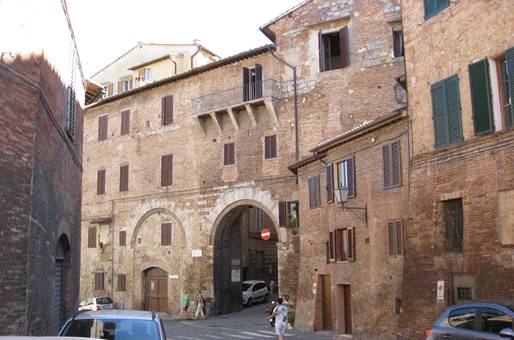
Arco delle Due Porte, the very ancient double gateway at the end of via Stalleregio
The church of San Niccolò
The entrance to the red-brick San Niccolò al Carmine is on the side of the church. Over the altar opposite the entrance, there is a huge painting by Beccafumi, Siena's chief mannerist painter (1485-1551), of St Michael the Archangel pushing Lucifer and the rebellious angels down to hell, with a fierce-looking God the Father urging him on from above (there is another version of this scene in the Pinacoteca). It has Beccafumi’s usual good light effects, unfortunately difficult to appreciate in the gloom of the church.
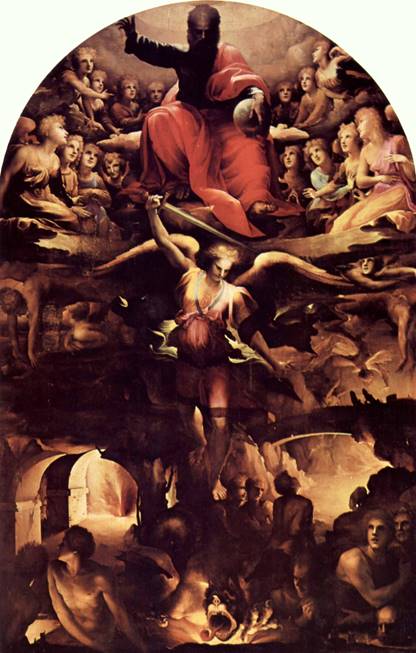
To the right is an unfortunately damaged fresco of the Assumption with a choir of heavenly angels, attributed to the early 15th century artist Benedetto di Bindo. The angels are managing to hover in a most relaxed and convincing way, playing a variety of instruments, around the now obliterated figure of the Virgin being assumed into heaven. At the bottom left of the fresco, on one side of her empty tomb, St Lucy is carrying her eyes on a plate (one of the various attempts at martyring her involved her eyes being torn out, subsequently to be miraculously restored), and St Catherine of Alexandria stands on the other side. The figure in front of the Tomb is Doubting Thomas, to whom according to legend the Virgin dropped her belt to prove that it was really her going up to heaven.
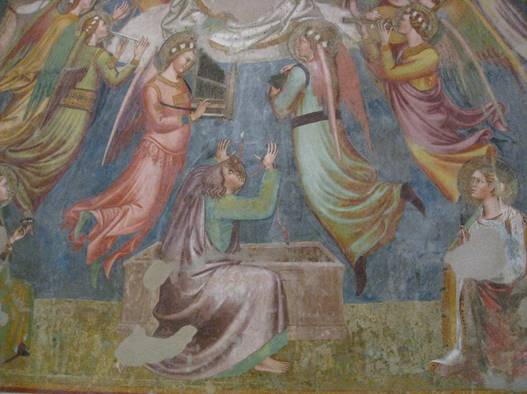
Detail from Benedetto di Bindo’s Assumption, showing the Virgin’s belt dropping into the hands
of the sceptical apostle Thomas
A door on the other side of the Beccafumi leads into the Chapel of the Holy Sacrament. Over the altar, there is a birth of the Virgin by Sodoma (painted about 1537), with a particularly large bevy of women fussing around the newly delivered mother. It has a handsome 16th century marble surround.
Back in the main church, next to the door into the chapel, there is 13th century byzantine-style Madonna and Child - the "Madonna dei Mantellini" inset into a larger and later painting by Francesco Vanni. The church also has a handsome 17th century polychrome marble main altar.
Next to the church, at No 44, is the old cloister of the convent. It is now part of Siena University, but still retains early 18th century frescoes illustrating Carmelite life by Giuseppe Niccola Nasini.
To the right of the entrance to the cloister, there stands the Palazzo Incontri, a large neo-classical structure built around 1800.
Porta San Marco and the Cappella della Madonna del Rosario
Beyond the church and to the right, the via di San Marco leads down to Porta San Marco, a city gate built as part of the fifth and last or outermost wall round Siena. The gate dates from the 1320s, like the neighbouring Porta Tufi. It is one of Siena’s least impressive entrances with no system of double gates. It was strengthened with a military fortification by Baldassare Peruzzi in the 16th century, but this has been demolished. It is also known as the Porta delle Maremme, as the road from it leads towards Grosseto and the Maremma region.
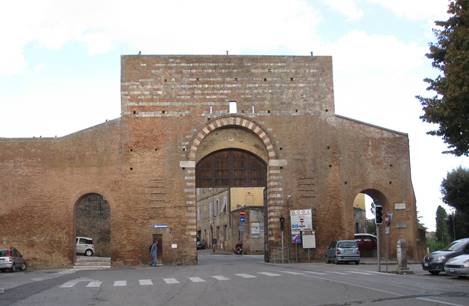
Porta San Marco from outside the city walls
A few hundred yards back up via San Marco, there is the charming baroque façade of the Cappella della Madonna del Rosario. This little chapel was built in the 1650s and gained its late baroque façade in the 1720s when the money from a Palio win was used by the local contrada – the Snail or Chiocciola – to enlarge it. The contrada seems subsequently to have abandoned the church and it was deconsecrated in 1820. But in recent years to has been brought back into use as a “House of the Horse” (Casa del cavallo) to stable the Snail horse in the run-up to the Palio, with young men of the contrada guarding it day and night to ensure that it is not nobbled by a rival.
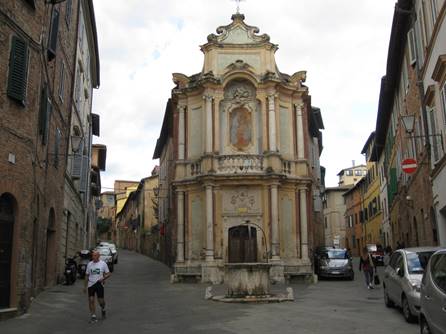
Cappella della Madonna del Rosario
1980s; revised 2015 and 2016.
***************************************************************************
SAN RAIMONDO AL REFUGIO
A small church in the via del Refugio (off via Roma) with a beautiful marble façade and a heavily decorated baroque interior. Worth a visit if passing. It used always to be shut, but recently a cultural offshoot of the Touring Club of Italy, “Aperti per Voi”, has arranged for volunteers to be there on certain mornings to allow for visits – see church door for details (at present – winter 2019 – it is open 09.30-13.00 Wednesday mornings).
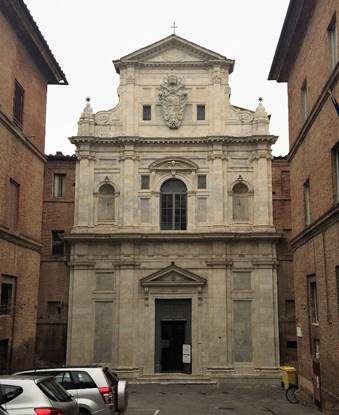
A member of a rich Sienese banking family, Aurelio Chigi, left money and instructions for the building of this church in his 1596 will. The present gleaming white marble façade was not added until 1660, after it was commissioned by Pope Alexander VII, another member of the Chigi family. It is not clear why Aurelio chose St Raymond of Penafort as the patron for his church – St Raymond was a 13th century Spanish lawyer who became a Dominican friar and drafted part of the Catholic Church’s canon law. The “Refugio” refers to an institution in the same street for the destitute daughters of impoverished nobility of which Aurelio was the director. The church is cleverly sited so that the façade can be seen from via Roma (the former main road to Rome) at the end of a vista down via di Refugio. It was damaged in the big Sienese earthquake of 1798, but no trace of the damage remains.
The façade follows classical principles, with the three orders of capitals – doric, ionic and corinthian – on succeeding floors. On the third level, the coat of arms of Pope Alexander VII, with the papal keys and crown, is splendidly displayed. The Chigi crest with its six superimposed hills and star above can be seen on either side, topping the corners of the church.
The interior is quite different. It was decorated in the early 1600s when the fashion was for heavy baroque decoration covering every part of the church. Specially designed gilded frames surround gloomy paintings by 17th century Sienese masters showing scenes from the lives of St Raymond, St Catherine of Siena and San Galgano (whose family palazzo is just round the corner), and St Catherine of Siena. The overall effect is oppressive to modern eyes, but there is no doubt of the skill of the work. The handsome white marble tombstone of Aurelio Chigi is in the middle of the aisle.
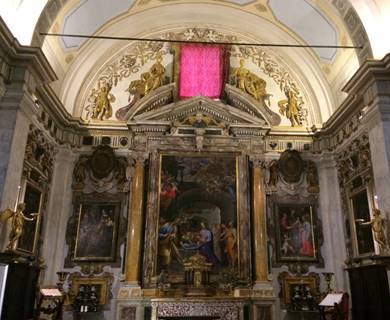
In the sacristy at the back of the church, along with the usual collection of old church paraphernalia, there are two painted wooden sculptures – a St Catherine of Alexandria lacking an arm, said to be by the most famous of Sienese Renaissance sculptors, Jacopo della Quercia (c.1374-1438); and a charming Virgin and Child by Lorenzo di Mariano (aka Il Marrina) (1476-1534) – see photo below.
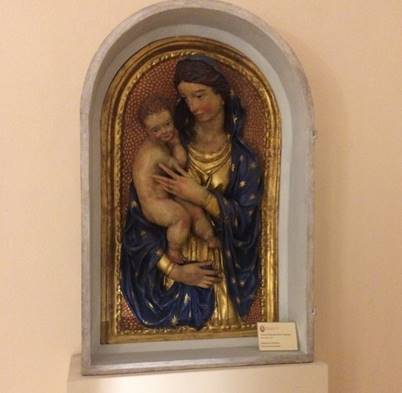
2019
*****************************************************************************
SANTO SPIRITO; and the PISPINI FOUNTAIN and GATE
A mainly classical church with good paintings by Sodoma, near one of Siena’s grandest city gates. Of moderate interest.
To reach this church, follow via Pantaneto, the continuation of the Banchi di Sotto, down the hill and turn left into the via Pispini, just after the massive neo-classical façade of the church of San Giorgio (almost always shut). You will see the red-brick façade of Santo Spirito in front of you. Unfortunately it is usually shut, except for a few open days during the summer (on which the Tourist Office can supply information).
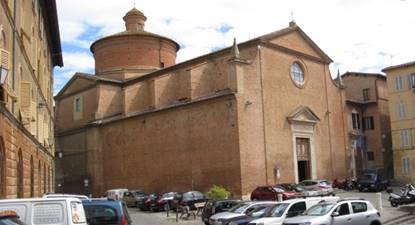
The church of Santo Spirito was originally built in the thirteenth century but its present interior is early sixteenth century and of typically elegant classical renaissance style, with symmetrical wide round arches and a large dome (not, however, a true dome architecturally speaking; as can be seen from the exterior, it is built inside a drum). Originally, the inside of the church probably had almost no decoration, but later in the baroque age stucco angels were attached to the sober classical lines, perching on ledges above the altar and providing an attractive asymmetry to the classical geometry of the church's bare architecture.
The church has a number of paintings of which the most interesting are the Sodoma pictures of saints above the altar in the first chapel on the right at the back of the church. The wishy-washy painting immediately above the altar in this chapel is not his, but most of the others show his vigorous style and were painted in 1530. On the left hand side of the chapel there is a good St Sebastian, and on the right is St Anthony the Abbot with his symbols of a bell on his wrist and a pig, a baby saddleback, at the bottom of the picture. At the top, St James of Compostella can be seen galloping over terrified Saracens. St James, one of the Apostles, died in 44 AD, many centuries before the Saracens appeared in Europe, but acquired a reputation in the early middle ages for returning in spirit form to help Christian armies fight the Saracens and Moors who were then invading the continent.
To the right of the main altar, behind a grill (light switch on the right) is an interesting crib scene with life-size figures of painted terracotta, allegedly by Ambrogio della Robbia (1554), one of the lesser members of the della Robbia clan. The statues have clearly been much repainted over the years, and the baby in particular looks far too romantic to have come from as far back as the sixteenth century. One of the shepherds is playing the bagpipes. (Bagpipes were according to one story introduced to Scotland by Italians from Cremona, who became the MacCrimmons, the hereditary pipers to the Clan MacLeod. In fact, bagpipes were probably a natural development in almost any society where animal skins were readily available.)
1980s.
Pispini Fountain and Gate
The pretty Fontana dei Pispini used to stand in front of Santo Spirito, but has recently been moved a few hundred yards further down the via Pispini, where it now stands opposite the church of San Gaetano, the church of the Contrada of the Shell or Nicchio (see the large shell above the church door). This fountain dates back to at least the 1400s, but was transformed into its present shape in 1536. The Shell contrada has adopted it as its official contrada fountain.
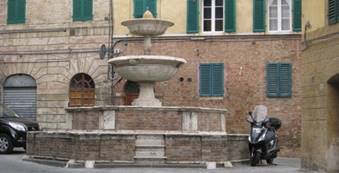
Fontana dei Pispini
A little further down, the via Pispini reaches the Gate of the same name, the Porta dei Pispini. It is a huge double gate, one of Siena’s grandest, built in the 14th century in Siena’s outer ring of walls (which were constructed when the city expanded out of the previous walls).
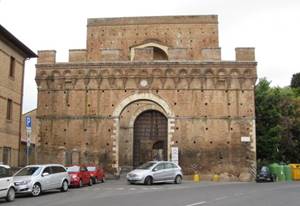
Porta Pispini
There were real threats to Siena in those days and the walls are soild constructions. Outside of the Porta Pispini, along on the left is the Fortino di Porta Pispini, the sole survivor of seven bastions designed by the great 16th century Sienese architect Baldassare Peruzzi to strengthen the defensive capacity of the wall.
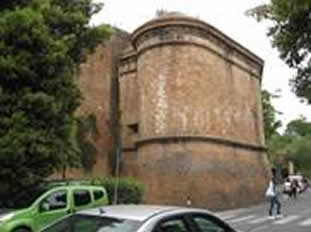
**************************************************************
CHURCH & CONVENT of the OSSERVANZA
A large red brick renaissance church overlooking Siena from a hill on the northern edge of the city, with good della Robbia figures.
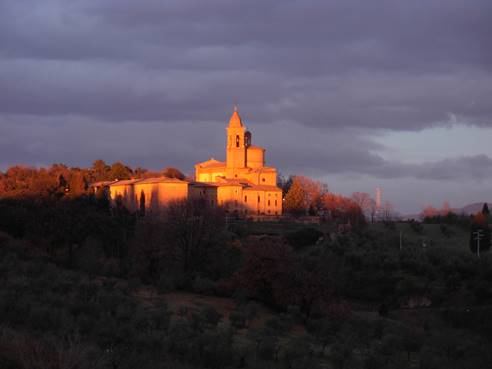
The convent of the Osservanza was the home of San Bernardino until he left Siena in 1444 to die in L'Aquila (St Bernardino was a Franciscan friar who became an immensely popular preacher, the Billy Graham of his day). When he lived here, it was a small convent; but after his death, as his cult grew, a large church was erected to accommodate the many pilgrims. Since its construction between 1476 and 1490, it has suffered many changes. It was baroquified in the eighteenth century, debaroquified in the 1920s, bombed in 1944 and reconstructed after the last war. Despite all these vicissitudes, it is still an elegant example of the Renaissance. It also contains some marvellous Andrea della Robbia glazed terracottas, probably the best of his work to be found in Siena.
Inside the church, on each side of the main door, are tondos by Andrea della Robbia of St Louis and of St Bonaventura. On either side of the chancel arch at the other end of the church are wonderful statues of the Archangel Gabriel and of the Virgin Mary, both rendered in pure white, again by Andrea della Robbia in around 1485. Note the charmingly natural pose of the Virgin. And finally in the second chapel on the left is a magnificent della Robbia high-relief altarpiece of the Coronation of the Virgin with a predella below with scenes of her life, in imitation of a painting of the period. This was badly damaged during the wartime bombing, but has been lovingly reassembled and restored. Unfortunately, it is very badly lit, and visibility is not helped by a barrier wired to an alarm that prevents anybody from approaching too close to the side chapels.
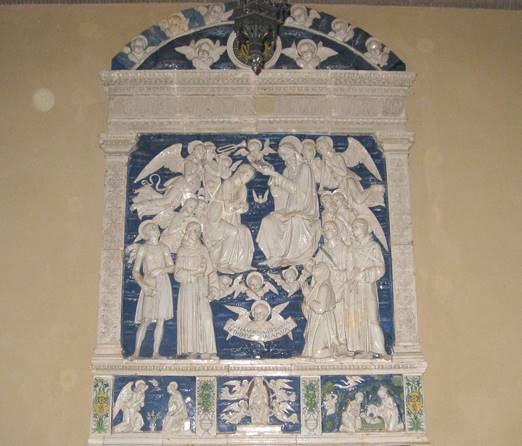
Coronation of the Virgin by Andrea della Robbia
There other sorts of good things in each of the side chapels. Especially fine are the Madonna and Child by Sano di Pietro in the first chapel on the left (switch on the light); the 16th century group in coloured terracotta, mourning over the dead Christ in the second chapel on the right; and a triptych by Sano di Pietro in the third chapel on the right, with the Virgin between Saints Jerome and Bernardino (St Jerome, one of the great doctors or learned men of the church, as so often holds a book in which he is pretending to write, although the page already seems full; St Bernardino is instantly recognisable by his hollow-cheeked and toothless look). On the left wall of the same chapel there is a portrait of San Bernardino, painted by Pietro di Giovanni Ambrosi in 1444, the year that the saint died, so it may well have been from life. In the fourth chapel is a further triptych, this time with St Jerome (in red, not even pretending to write this time) and St Ambrose, dated 1436 by an unknown painter now known after this painting as the ‘Master of the Osservanza’.
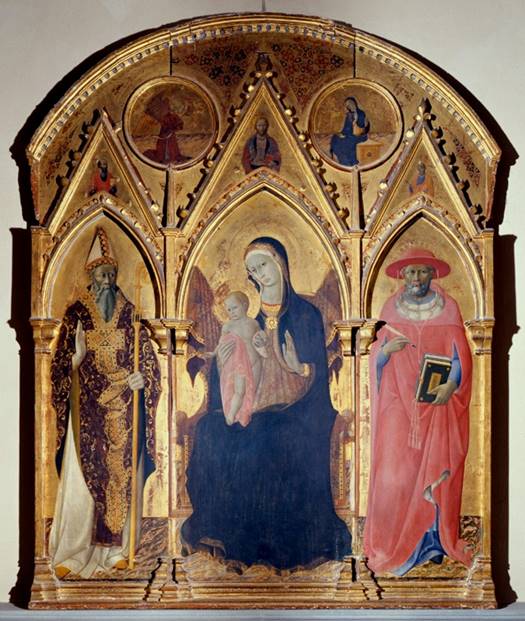
If there is a monk in the church ask to be shown the sacristy (through a door to the right of the altar): it contains a further wonderful polychrome terracotta group mourning the dead Christ attributed to Giocamo Cozzarelli. This is more mannerist in style, with the various saints and apostles striking intensely tragic attitudes. Off the sacristy is a small museum with illuminated manuscripts; beautifully embroidered old vestments; some - mostly modest - paintings and statues (good but damaged fresco of St Michael the Archangel, originally from the crypt); and other odds and ends.
The altar and the chancel suffered most from the bombing and are a complete reconstruction.
(1980s and 2015)
***********************************************************
SYNAGOGUE
Siena's 18th century Sephardi synagogue.
The synagogue is at 14 vicolo delle Scotte, a tiny lane entered through archways from either via Salicotto (which runs down the left side of the Palazzo Pubblico) or via del Porrione, to the right of the façade of San Martino. The synagogue is open Sunday, Monday and Thursday from 10.30 to 17.30 and other days (except Saturdays) by appointment. During the open days, visits are every half hour and are preceded by a short presentation.
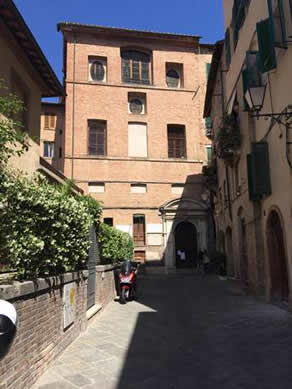
There has been a Jewish community in Siena since at least 1229. The Jews were not particularly well-treated, being considered “Despisers of the Most Glorious Virgin Mary” (Siena’s traditional protectress), but nevertheless flourished as money-lenders and bankers despite the competition from the Monte dei Paschi. Things went particularly badly after the Medici takeover of Siena. In 1571 Grand Duke Cosimo dei Medici ordered that they be confined to a ghetto area below the Campo and imposed various other restrictions.
When the French revolutionary forces entered Siena in 1796, they tore down the gates of the guetto and ceremoniously burnt them in the Campo. This emancipation of the Jews was not to last long. There was a counter-revolution against the French in 1799, during which members of a fanatical religious association called “Viva Maria”, founded in Arezzo, burst into the synagogue while the congregation was at prayer. In probably the most shameful episode in Siena’s history, a huge bonfire was built in the Campo and thirteen Jews, including six women, were burnt alive, the Church authorities turning a blind eye. After that, confinement of the community to the ghetto lasted another sixty-odd years (until the uinfication of Italy). The Jews finally attained full citizenship only in 1895.
Construction on the present synagogue began in 1756, on the site of an earlier building. The community employed as their architect a Florentine, Giuseppe del Rosso, who had worked on several churches in Florence. The outside of the synagogue is very plain, more like a private house, as the Jews were not supposed to build new places of worship. The interior, however, is sumptuous in a neo-classical style unusual in Siena at that period. The community employed master woodworkers and there is also excellent marble carving, despite the fact that sysnagogues were not supposed to use marble as that would be rivalling churches. The marble used for the columns on either side of the Torah Ark is said to come from Jerusalem, although this seems somewhat unlikely (and would be coals to Newcastle).
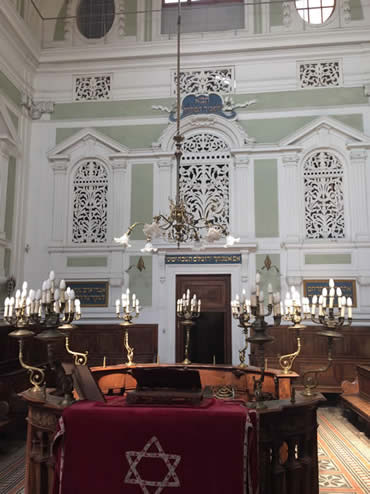
Interior. There is a woman's gallery upstairs.
There are plaques outside the synagogue, commemorating both the 13 people burnt in 1799 and Siena’s Holocaust victims.
There is also a Jewish cemetery, still in use, at 17 Strada Linaiolo, outside the Porta Romana, to which there are periodic guided tours (telephone 0577 49272).
2019.
******************************************************************************